The Problem
Big Solar: Big Footprint
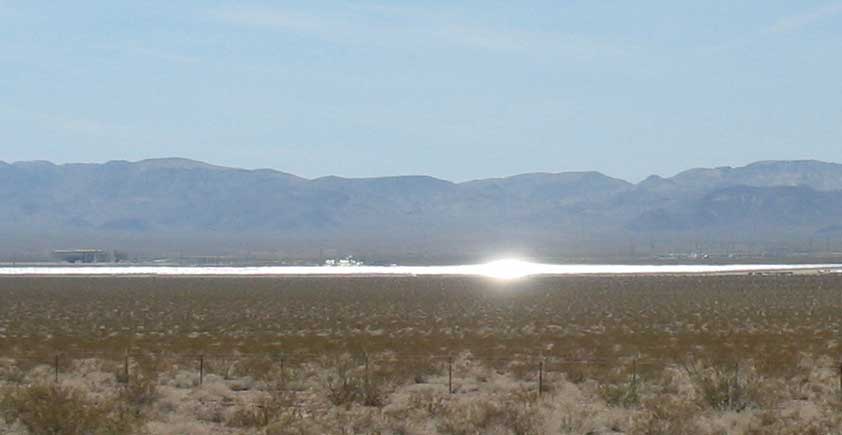
<Nevada Solar 1 concentrated solar power plant, its mirrors gleaming in the sun across almost a square miles of desert.
Continued from page 1, The Problem...
BLM has not yet started National Environmental Policy Act (NEPA) work, "but is getting close." This would include studying potential impacts on animals like the Desert tortoise and on rare plants, as well as archaeological, tribal, and historical resources.
Areas for the solar reflector plants need to be flat or less than 3% slope, although some companies say they will terrace. The land will be basically sterilized, graded. Some companies are applying for "phase 1" applications, with the intent of applying for "phase 2 and 3" projects in the future. Not all will be permitted. Other companies are "stacking" into applying for the same areas of land, if the first-in-line application company does not get permitted. For some areas there are 3 companies in line to try to get a permit for the same acreage.
To the credit of BLM and Tom Seley, BLM is trying to recommend companies use disturbed land, such as waste rock piles.
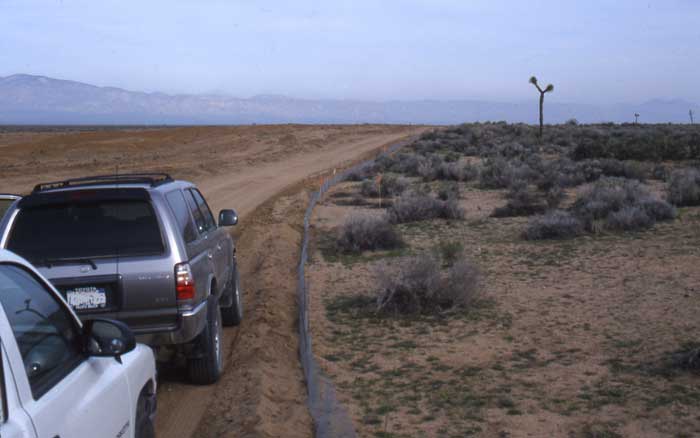
^Biologists monitor a new development in the Mojave Desert for Desert tortoise. A small fence keeps tortoises from being crushed by giant scrapers. The tortoises will be dug out of their burrows and translocated to other areas, a method that has not proven to work well for this threatened reptile -- many die from Coyote predation and drought after being moved out of their familiar home ranges.
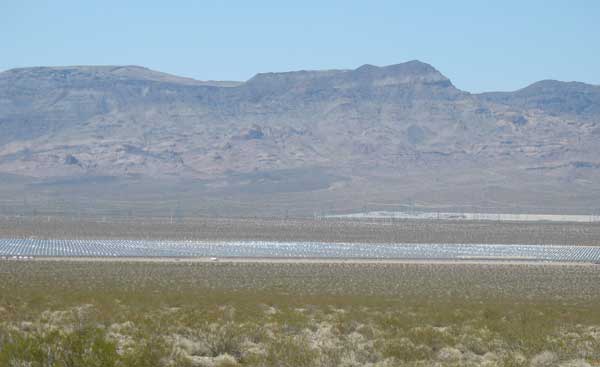
^The completed plant: Nevada Solar One south of Las Vegas, a 75 megawatt parabolic mirror array.
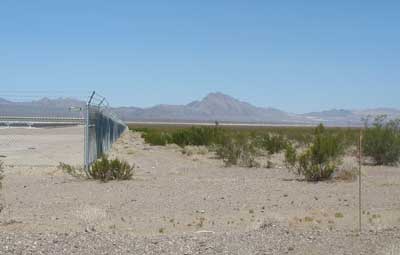
^The edge of the concentrated solar power plant, Nevada Solar One, showing how creosote desert must by bulldozed and scraped away completely to build the linear reflectors.
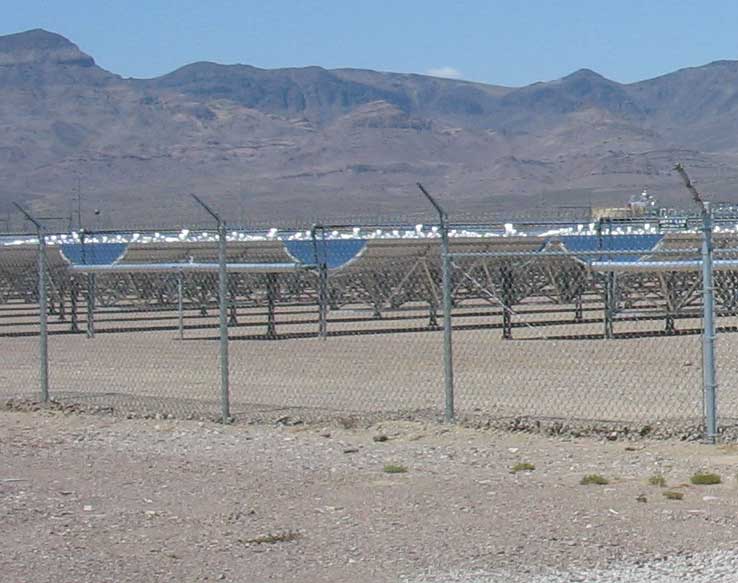
^The parabolic trough reflectors.

^Concentrated solar power leaves a big footprint in natural habitats and is often distant from cities.
Groundwater pumping
Concentrated solar power reflectors, unlike photovoltaic panels, need to be cleaned heavily out in the desert. The steam cycle requires 8% of the total water consumption in these plants, but by far the largest use is cooling towers in traditional wet-cooled plants (which will be the dominant type in the Amargosa Desert). Ninety percent of water consumption goes into the cooling system to transfer waste heat into the environment. 800 to 1,000 gallons of water are consumed per megawatt-hour. (See more on how these solar power plants work >>here.)
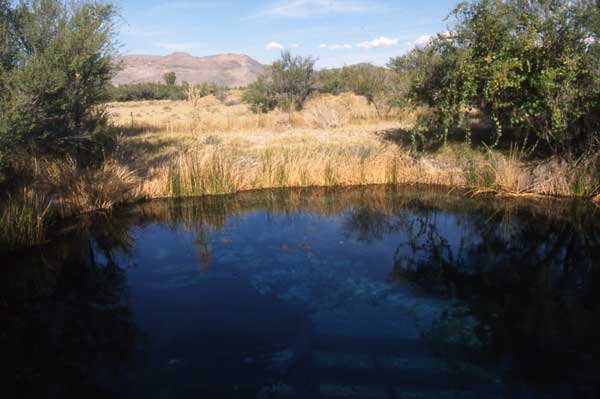
^Ash Meadows National Wildlife Refuge has many springs, lakes and wetlands fed by the underground aquifer in the Amargosa Desert. Endemic pupfish live in this spring.
Roughly 60,000 acres of the Amargosa Desert in California and Nevada has been targeted for solar development. Brian Brown of the Amargosa Conservancy calculated that the amount of water needed if all this happened would equal twice the annual recharge of the entire Amargosa Basin. Concentrated solar thermal power plants need 6 acre-feet of water per megawatt. Nevada Solar One in Clark County uses 400 acre-feet of water per 64 megawatts.
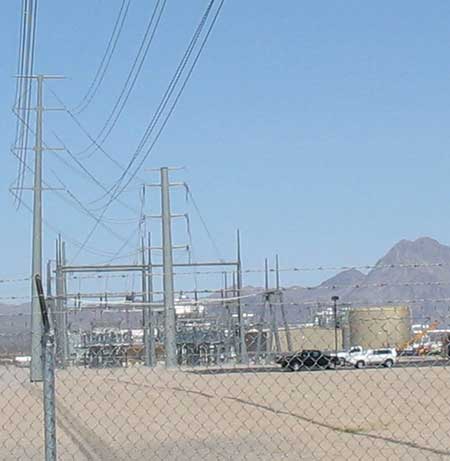
^Solar One Nevada reflectors heat liquid in receiver pipes that feed into a heat exchange system that makes steam to run turbines -- this generates the electricity that travels off on large powerlines. The steam generation is the same technology that coal-burning, natural gas-burning and nuclear power plants use, so these concentrated solar power plants can be hybridized to such conventional plants. Is this our future?
If these large CSP plants were built next to cities they could take avantage of treating city wasteater as their source.
Most companies are going to California and Arizona first, to get sites by major existing powerlines. Nevada has a lack of powerlines, so the future cost of alternative energy should factor the cost of the transmission infrastructure in as well. Plans are being made to place major powerlines in Nevada, following the Western Energy Corridor map. One proposed powerline would come right through the middle of Oasis Valley and Beatty. BLM commented that this should be removed out of Oasis Valley wetlands and Amargosa toad habitat (a BLM sensitive species), and out of the town of Beatty. Other conflicts with local residents and biodiverse habitats will likely occur.
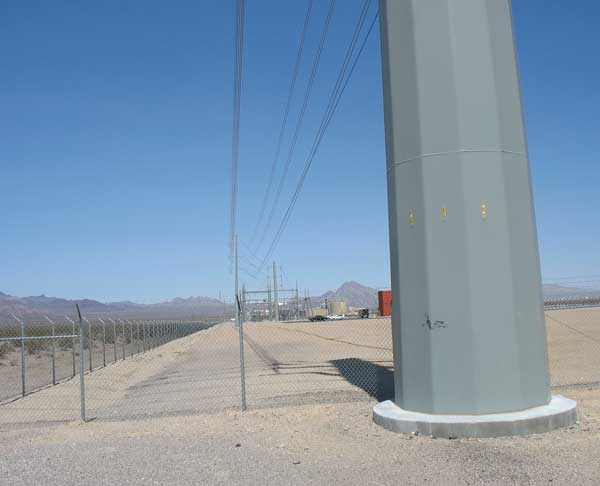
^Towering powerline runs off from Solar One Nevada to connect to the power corridor stretching across the desert (below).

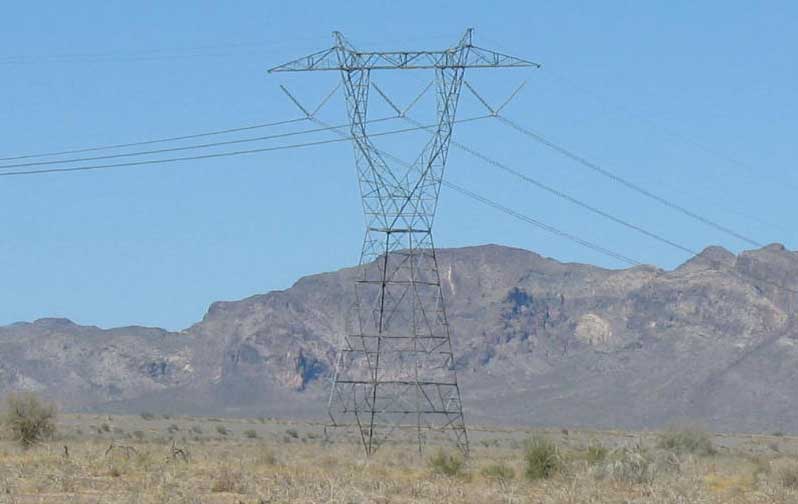
Union leaders complained that Nevada Solar One, the Boulder City energy zone's first renewable power plant built by the Spanish company Acciona Energy, promised to hire local Nevada workers but instead hired workers from Central America "at a fraction of the cost." Councilwoman Linda Strickland said that if the city required in its contract the companies use local labor, it would be difficult to enforce. See our story on Boulder City's new photovoltaic power plant >>here.
Greenhouse Gases Will Still Be Produced
A natural gas-burning power plant lies next to the solar thermal and new photovoltaic power plants in the El Dorado Valley south of Boulder City, providing the base power for these intermittant renewable plants.
California regulations allow concentrated solar power plants to generate up to 25% of their electrical output from burning natural gas (after this the plant would be called a hybrid renewable-fossil fuel plant). The proposed 4,000-acre power tower system plant at Ivanpah Valley, San Bernardino, California, would burn natural gas at night to keep the water in the steam system warm (Desert Report, Sierra Club California/Nevada Desert Committee, December 2008:12). A natural gas pipeline would be utilized to ship fuel in from the Bighorn Generating Station, a 598-megawatt natural gas-fired power plant near Primm, Nevada.
See more photos of the beautiful Amargosa Desert>>
2/09 Update: Amargosa Solar Companies Tour the Area >>here.
3/09 Update: Solar Companies Moving on Amargosa Valley >>here.
